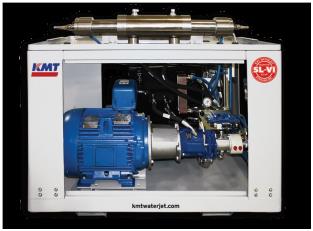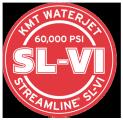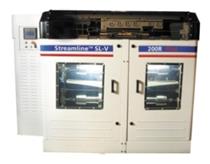Intensifier Pump Selection
PST integrates the KMT Intensifier Pump and KMT Cut Head for each of its systems. KMT Waterjet Systems (formally the Ingersoll Rand pump division - Baxter Springs, KS) has designed the finest High Pressure Pumps in the world market. The high pressure pump is the heart of the waterjet system commonly operating at pressures exceeding 50,000 psi and in some applications 90,000 psi. The industry consists of two types of pump technologies – direct drive and Intensifier. In general direct drive pumps are slightly less expensive, however require significant maintenance as compared to the Intensifier Pumps.
Upon selecting a pump, one needs to insure they have ample horsepower to meet cutting demands and should evaluate the type of materials commonly cut, thickness and number of cut heads required to determine horsepower requirements. The table below outlines the general category based on similar material types and commonly used orifice sizes. Pure water cutting (non-abrasive) require a small orifice size therefore less horsepower compared to abrasive metal cutting. In general denser materials require a larger orifice size to increase cutting speed therefore an increase in horsepower. Some users may only cut a few hours a day where cut speed are less important, therefore a smaller pump will suffice.
Upon selecting a pump, one needs to insure they have ample horsepower to meet cutting demands and should evaluate the type of materials commonly cut, thickness and number of cut heads required to determine horsepower requirements. The table below outlines the general category based on similar material types and commonly used orifice sizes. Pure water cutting (non-abrasive) require a small orifice size therefore less horsepower compared to abrasive metal cutting. In general denser materials require a larger orifice size to increase cutting speed therefore an increase in horsepower. Some users may only cut a few hours a day where cut speed are less important, therefore a smaller pump will suffice.

Overview of Intensifier vs Direct Drive Pumps :
| Direct Drive | Intensifier Technology | |
| Horsepower Selection | Limited 30 HP | 30 HP - 200 HP |
| Max Pump Pressure | 55,000 psi | 60,000 psi , optional 90,000 psi |
| Purchase Cost | Lower | Higher |
| Maintenance Expense | Higher | Lower |
| Maintenance Intervals | 250 - 400 hours | 800-1000 hours |
| Utility Cost | Lower | Higher |
| Pressure Quality | Pulses - less desirable | Steady - improved cutting quality |
| Tool Kit | Expensive | Lower Cost |
Until Direct Drive technology is improved, PST Waterjets are sold with the KMT Intensifier Pump. Intensifiers are offered from 30 hp to 200 hp based on the cutting application and number of cut heads required. KMT Intensifiers operate at 60,000 psi with a series of ultra high pressure pumps that operate at 90,000 psi. The typical cutting application operates at pressures ranging from 45,000 to 60,000 psi.
As you increase pump horsepower, GPM increases yielding the ability to power a larger cut head orifice. This larger orifice increases cutting speeds by 20-40%. The chart below reflects horsepower, orifice size, and cut speeds for various materials. The glass cut speed for "smooth edge quality would be a temper ready edge quality requiring no secondary finishing
As you increase pump horsepower, GPM increases yielding the ability to power a larger cut head orifice. This larger orifice increases cutting speeds by 20-40%. The chart below reflects horsepower, orifice size, and cut speeds for various materials. The glass cut speed for "smooth edge quality would be a temper ready edge quality requiring no secondary finishing
Various Material Cut Speeds vs Pump Horsepower:
| Material | Thickness | Horsepower | Orifice Size | Medium Edge | Smooth Edge |
| Glass | 0.375" | 30 HP | 0.011" | 37 ipm | 21 ipm |
| 50 HP | 0.014" | 52 ipm | 29 ipm | ||
| Granite | 2 cm | 30 HP | 0.010" | 13 ipm | 6 ipm |
| 50 HP | 0.014" | 19 ipm | 9 ipm | ||
| Aluminum | 0.250" | 30 HP | 0.010" | 60 ipm | 30 ipm |
| 50 HP | 0.014" | 70 ipm | 38 ipm | ||
| Steel | 0.250" | 30 HP | 0.010" | 16 ipm | 8 ipm |
| 50 HP | 0.014" | 25 ipm | 12 ipm |
Shower Door Cutting Time:
Time to cut 3/8” glass shower door.
Two hinges and hardware holes - temper ready edge quality.
Abrasive type - 120 grit
Two hinges and hardware holes - temper ready edge quality.
Abrasive type - 120 grit
•
30 HP, Orifice 0.010 = 3:10 min
•
40 HP, Orifice 0.012 = 2:45 min
•
50 HP, Orifice 0.014 = 2:30 min
Cut Speed Calculator:
One can visit the KMT Waterjet webpage and select the online cut speed calculator. This provides speeds based on material type & thickness, orifice size and pressure. As you change any variable the cut speeds adjust accordingly. If you purchase a larger 100 hp pump and elect to run a small 0.010” orifice jewel it will cut at the same speed as a 30 hp pump with a 0.010” orifice. All the cut head understands is GPM is sufficient, orifice jewel size installed, and pressure being delivered. If you increase pressure alone cut speeds will increase. The standard in the American industry is 60,000 psi pumps and some applications the ultra high pressure 90,000 psi technology maybe a good fit.
Pump Selection Criteria:
Number of hours a day the Waterjet will be operating?
Compare cut speed for your materials vs horsepower vs pump price?
Will dual cut heads be required immediately or in the future?
At what pressure will the pump be typically operating?
Will I be operating one or two cutting tables with a single pump?
Does 90,000 psi vs 60,000 psi capability make financial senses?
Compare cut speed for your materials vs horsepower vs pump price?
Will dual cut heads be required immediately or in the future?
At what pressure will the pump be typically operating?
Will I be operating one or two cutting tables with a single pump?
Does 90,000 psi vs 60,000 psi capability make financial senses?

KMT Intensifier Pumps:
KMT (Ingersoll-Rand) have built watertjet pumps since the 1970's with the introduction of the Model SL-1. Since that time the maximum pressures have increased from 45,000 to 90,000. Pumps operate with lower utility cost and required maintenance intervals are extended. In 2016 KMT introduced the newly designed Streamline Model SL-6 with enhanced upgrades.
KMT Intensifier
Model Streamline SL-6
Model Streamline SL-6

•
Newly updated technology 2016
•
Horsepower Selection - 30 hp , 40 hp , 50 hp , 100 hp
•
Long 8" stroke length - less wear
•
Life Long Ceramic Plungers
•
Status, test monitoring, diagnostics
•
Redesigned low / high voltage electrical panels
•
Reduced Electrical consumption
•
Siemens PLC Electrical Panel
•
Enhanced Motor efficiency
•
Ethernet / USB connection
•
Cycle Times / Maintenance
•
Built in Booster Pump
•
Optional Air Cooling

For intensifier pump specifications visit:
http://www.kmtwaterjet.com/
http://www.kmtwaterjet.com/
KMT 90,000 psi Pump Technology:
KMT offers two pumps that will consistently develop 90,000 psi. The increase in pressure from 60,000 to 90,000 will commonly increase the cut speeds from 50% to 100% based on material type. This increase in productivity comes at the expense of added pump maintenance intervals and a higher capital expense. All components including - piping, filters, and cut head are specifically designed for this ultra high pressure. KMT can provide a “cost of operation” spreadsheet so one can compare the advantage of this technology versus a 60,000 psi system. The 90K systems are commonly sold into larger contract cutting operations and heavy metal fabricators.

Pump Cooling / Chiller Requirements:
All KMT Intensifier Pumps require water flow or a closed loop chiller to control heat build-up in the hydraulic oil, the ideal oil temperature is 115 degrees. Operating within the ideal temperature range moderately extends the life of high pressure seals. In most cases the domestic water flow provides sufficient cooling even in seasonal ambient conditions above 100 degrees. Please understand a closed loop chiller unit is required on all Direct Drive pumps and this is not the case concerning Intensifier Pump technology. Based on this clarification PST does not automatically include chillers within our waterjet proposals. KMT estimates 95% of their Intensifier Pumps operate without use of a closed loop chiller. A chiller unit can always be installed and placed in service at any later date if not initially installed.
Common reasons to consider a Closed Loop Chiller:
•
Our facility is connected to a septic sewage system.
•
Economics, water usage includes a City sewage fee in our City.
•
Water usage is restricted in summer months.
•
No facility drain that can be piped into.
The chart below outlines the cooling water (GPM) required as compared to chiller size in BTU’s. The pump hydraulic system is thermostatically controlled. During start-up or continuous loading of the pump the thermostat opens wider to provide up to the maximum water flow. If the pump is idle or operating at a lower pressure it’s built in thermostat will partially close reducing water flow requirements.
| HORSEPOWER | WATER (GPM) | BTU/Hr |
| 30 HP | 0 - 2.5 | 22,000 |
| 50 HP | 0 - 3.0 | |
| 60 HP | 0 - 3.5 | 38,000 |
| 75 HP | 0 - 4.0 | |
| 100 HP | 0 - 4.5 | 58,000 |
Chiller Features:
•
Chillers include PVC piping kit
•
Glycol additive provided
•
Hermetic Scroll Compressor
•
Air Cooled Condenser
•
Manual Bypass for specific flow adjustment
•
Stainless Steel Reservoir construction
•
Vertical design to reduce floor space
Water Requirements - testing prior to purchase:
Prior to purchase of a waterjet system one should test the condition of their water, dynamic flow rate (GPM ) and pressure. As pump horsepower increases the required water flow rate increases. Should your facility water pressure be less than 35 psig an inlet water booster pump is required, most KMT pumps have this built-in to the pump design. PST can arrange to have a water sample analyzed by an independent third party laboratory. The analysis reflects the current condition, minimum operating parameters along with ideal levels of purity.
Every PST Waterjet is quoted to include inlet micron filters to guard against particulates. In most cases simple filtration is sufficient, on occasion requires advanced water conditioning such as a reverse osmosis system. Once test results are available PST can provide a recommended water treatment solution. Some facilities with septic systems require complete water closed loop systems having limited drain capability
Every PST Waterjet is quoted to include inlet micron filters to guard against particulates. In most cases simple filtration is sufficient, on occasion requires advanced water conditioning such as a reverse osmosis system. Once test results are available PST can provide a recommended water treatment solution. Some facilities with septic systems require complete water closed loop systems having limited drain capability
Download our line card
Click Shop above to browse our NEW e-commerce site
Precision Solutions for Cutting and Glass Processing Excellence
- Aculite CNC Cutting
- Glass Machinery
- Glass Processing Tables
- Auto Freefall Glass Loading
- Insulated Unit Assembly
- Automatic Applicator Table
- Tilt Top Grid Assembly Table
- Prem. Auto Seal Applicator Table
- Prem. HTT Applicator Table
- Easel Grid Table
- LKO Rotating Sealing Table
- Power Rotating Sealing Table
- Cold Single Set Roller Press
- KKO-17 Rotating Sealing Stand
- Hot Melt Clamp Table
- Desiccant Filling Machine
- Application & Hot Melt Clamp
- Glass Processing Equipment
- Glass Inspection Units
- Glass Storage Racks
- Glass Washing Equipment
- Glass Lifting Devices
- Waterjet Machinery
- Glass & Glazing Supplies
- PST Machine Parts
- Services
- Software
- Video Demos




